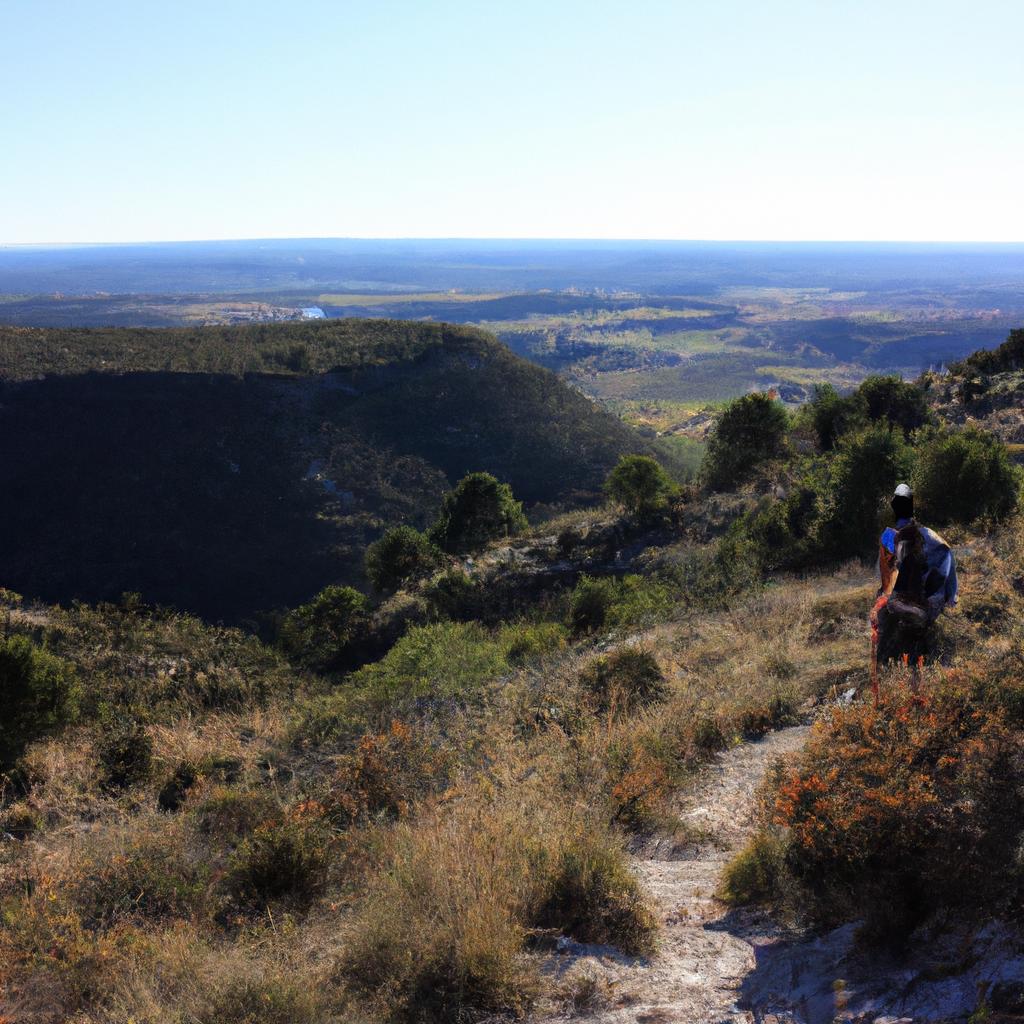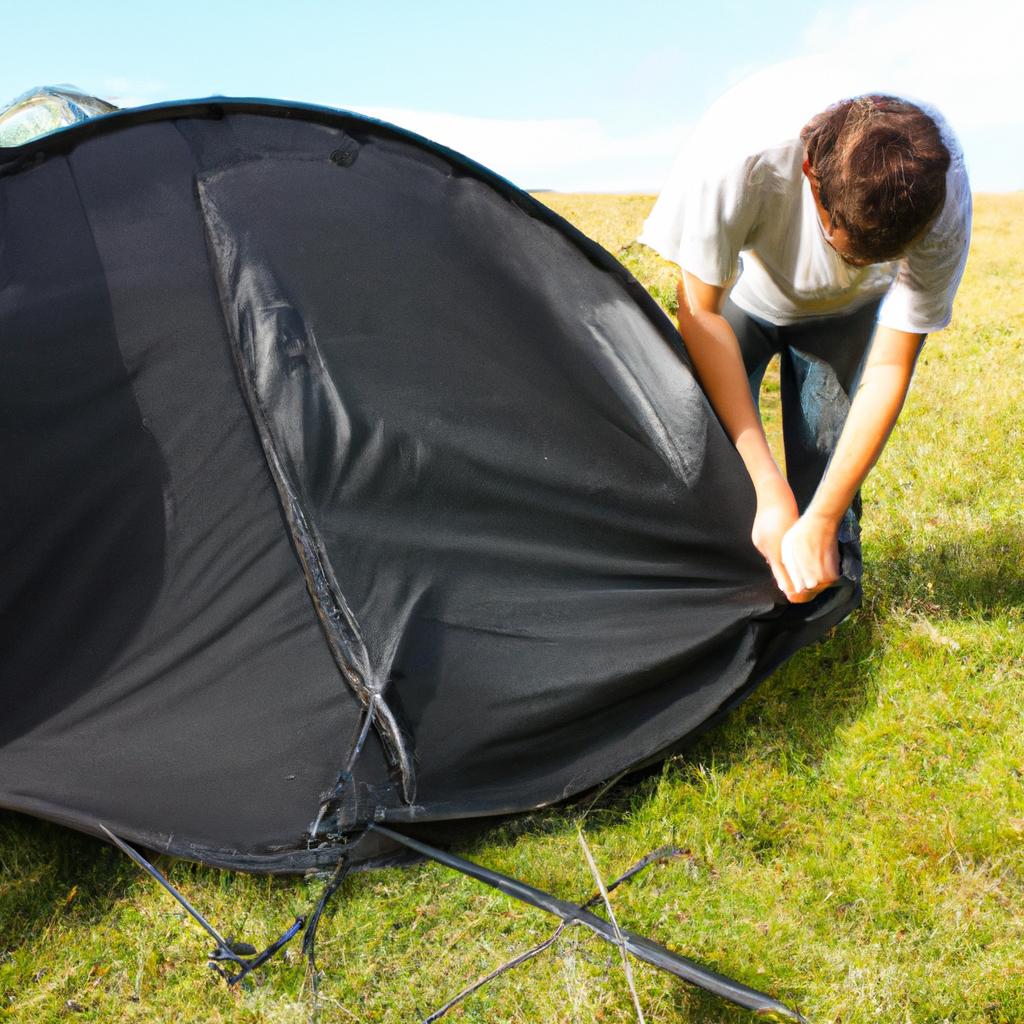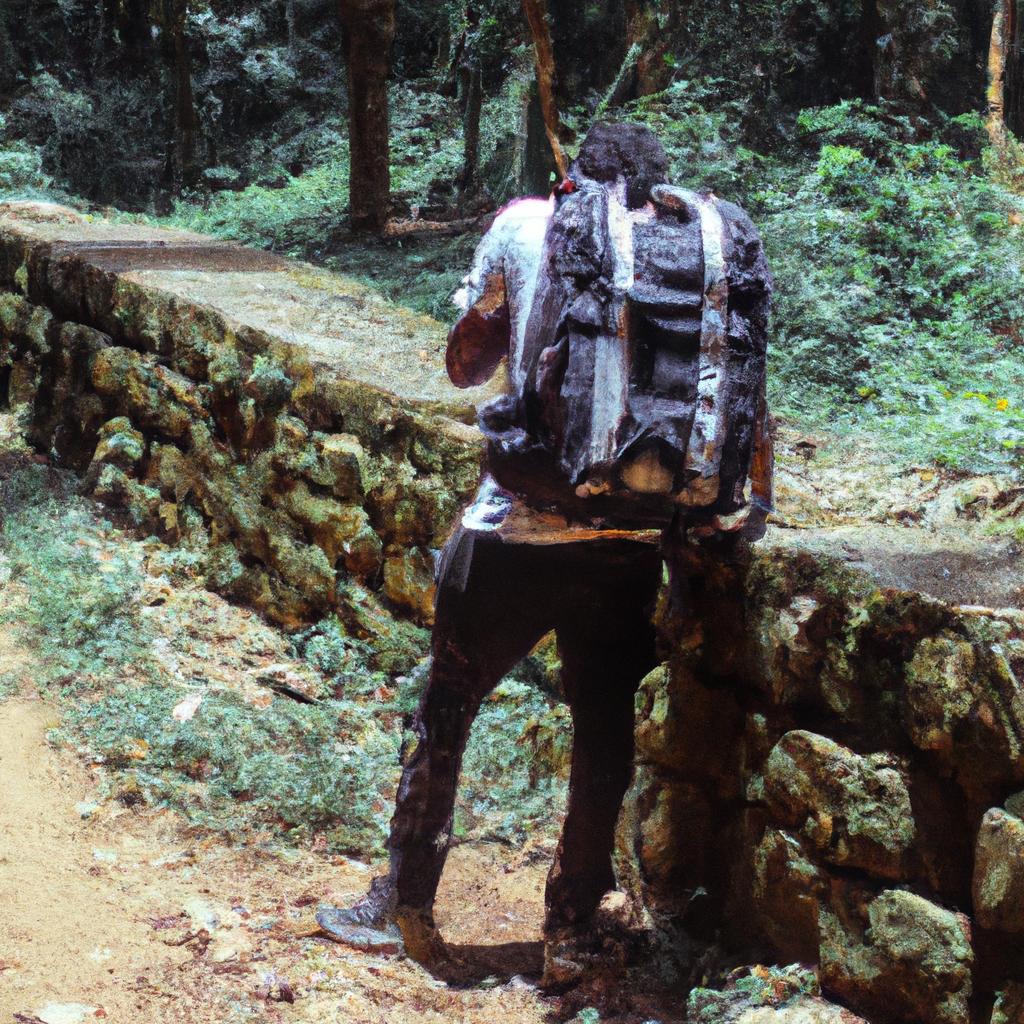Hiking is a popular outdoor activity that allows individuals to immerse themselves in nature while also engaging in physical exercise. The allure of hiking lies not only in the opportunity to explore breathtaking landscapes, but also in the sense of accomplishment one feels upon reaching a destination after traversing rugged terrain. For those seeking an unforgettable camping experience intertwined with invigorating hikes, this article serves as your ultimate guide to discovering the best hiking trails and campground adventures.
Imagine embarking on a journey through dense forests, ascending steep peaks, and crossing babbling brooks as you make your way towards a hidden gem nestled deep within the wilderness. One such example is Devil’s Lake State Park located in Wisconsin, USA. This park offers a plethora of scenic trails catering to hikers of all skill levels. Whether you are an experienced trekker or just starting out, there are options available for everyone. From the challenging East Bluff Trail that rewards adventurers with panoramic vistas from atop towering cliffs, to the more leisurely Tumbled Rocks trail that winds through peaceful woodlands alongside tranquil streams – Devil’s Lake State Park truly has something for every nature enthusiast.
Research popular hiking trails in your desired location
Researching popular hiking trails in your desired location is an essential first step to planning a successful camping adventure. By gathering information about the available options, you can make informed decisions that align with your interests and preferences. For instance, imagine you are planning a trip to Yosemite National Park. Conducting research on hiking trails in this location will help you uncover hidden gems like the Mist Trail, which offers stunning views of Vernal Falls.
When researching popular hiking trails, there are several factors to consider. First and foremost, it’s crucial to assess the difficulty level of each trail. This information allows you to gauge whether a particular hike aligns with your fitness level and experience as a hiker. Additionally, understanding the distance and elevation gain of each trail provides valuable insights into its challenges and time requirements.
To evoke an emotional response from readers, here is a bullet point list showcasing the benefits of exploring popular hiking trails:
- Immerse yourself in nature’s beauty
- Challenge yourself physically and mentally
- Experience a sense of accomplishment upon completing a trail
- Rejuvenate your mind by disconnecting from technology
Furthermore, utilizing a table format can enhance readability while evoking emotions related to anticipation and excitement for the upcoming adventure. Consider this example table highlighting three popular hiking trails in Yosemite National Park:
| Hiking Trail | Difficulty Level | Distance (miles) | Elevation Gain (feet) |
|---|---|---|---|
| Mist Trail | Moderate | 3 | 1,000 |
| Half Dome | Strenuous | 14 | 4,800 |
| Upper Yosemite Falls | Difficult | 7 | 2,700 |
In conclusion, conducting thorough research on popular hiking trails in your desired location sets the foundation for an enjoyable camping adventure. By considering factors such as difficulty level, distance, and elevation gain, you can choose a trail that aligns with your fitness level and interests. With this information in hand, you are now ready to proceed to the next step: checking trail difficulty ratings and selecting a trail suitable for your fitness level.
Check trail difficulty ratings and choose a trail suitable for your fitness level
Imagine you have decided to embark on a hiking adventure in the picturesque mountains of Colorado. You’ve done your research and found several popular hiking trails that catch your interest. Now, it’s time to narrow down your options and choose a trail that suits your fitness level and preferences.
When selecting a trail, there are several factors to consider. First and foremost is the difficulty rating of the trail. Assessing this will ensure that you can comfortably complete the hike without risking injury or exhaustion. For instance, let’s take a look at one of Colorado’s most famous hikes – The Manitou Incline. With its steep incline gaining 2,000 feet of elevation over less than one mile, this trail is rated as extremely challenging. It requires excellent physical fitness and endurance levels due to its demanding nature.
To further guide you in choosing an appropriate trail, here are some key considerations:
- Trail Length: Determine how long you want your hike to be—whether short and leisurely or long and strenuous.
- Elevation Gain: Consider how much elevation gain you’re comfortable with tackling during your hike.
- Terrain Type: Decide if you prefer well-maintained paths or more rugged terrain for a thrilling experience.
- Scenic Views: Think about whether breathtaking views are essential for your hiking enjoyment.
Below is a table outlining different hiking trails in Colorado along with their corresponding difficulty ratings, lengths, elevation gains, and notable features:
| Trail | Difficulty Rating | Length (miles) | Elevation Gain (feet) | Notable Features |
|---|---|---|---|---|
| The Manitou Incline | Extremely Challenging | 1 | 2,000 | Steep ascent; panoramic view from the top |
| Hanging Lake Trail | Moderate | 3 | 1,000 | Stunning turquoise lake; waterfalls along the way |
| Royal Arch Trail | Challenging | 3.4 | 1,400 | Natural rock arch formation; scenic overlooks |
| Maroon Bells Scenic | Easy | 0.9 | No significant gain | Iconic mountain views and picturesque lakes |
By carefully evaluating these factors and referring to the table above, you can choose a hiking trail that matches your fitness level, preferences, and desired experience. Once you’ve made your decision, it’s time to prepare for your adventure by packing essential hiking gear.
Pack essential hiking gear, including proper footwear, water, and a map. This will ensure that you’re well-equipped for the chosen trail and ready to immerse yourself in the beauty of nature while enjoying an unforgettable camping adventure.
With your ideal hiking trail selected and necessary gear packed, let’s move on to planning other crucial aspects of your campground adventure.
Pack essential hiking gear, including proper footwear, water, and a map
Example Scenario:
Imagine you are an enthusiastic hiker looking to embark on a thrilling adventure amidst nature. As you plan your trip, it’s vital to select a trail that aligns with your preferences and abilities. Let’s explore some factors to consider when choosing the perfect hiking trail.
Trail Selection Criteria:
-
Distance: The length of a hike can greatly impact your overall experience. Some individuals prefer short, leisurely hikes for a quick escape from their daily routine, while others seek more challenging long-distance treks. Consider how much time you have available and what level of physical exertion you are comfortable with.
-
Elevation Gain: The amount of elevation gain along a trail determines its difficulty level. Steep ascents may provide breathtaking views at the summit but require greater endurance and strength. On the other hand, trails with minimal elevation changes offer a smoother journey suitable for beginners or those seeking a more relaxed hike.
-
Scenery and Terrain: Take into account the type of landscape you wish to explore during your adventure. Are you drawn to lush forests filled with towering trees? Or perhaps panoramic vistas atop rugged mountains appeal to you? Research different trails beforehand to ensure they match your desired scenic backdrop.
-
Trail Conditions: Familiarize yourself with any potential challenges or hazards associated with specific trails. Factors such as rocky terrain, river crossings, or exposure to extreme weather conditions could affect both safety and enjoyment levels throughout your hike.
To further illustrate these criteria, refer to the table below showcasing three popular hiking trails along with relevant information regarding distance, elevation gain, scenery/terrain, and notable features:
| Trail Name | Distance (miles) | Elevation Gain (feet) | Scenery/Terrain | Notable Features |
|---|---|---|---|---|
| Rocky Peak Trail | 5.2 | 1,500 | Mountainous/Scenic Vista | Stunning views |
| Forest Haven Loop | 3.8 | 400 | Wooded Trails | Waterfalls |
| Coastal Cliff Trail | 6.7 | 800 | Coastal/Rocky Terrain | Beach access point |
Considering these criteria and examples will help you make an informed decision when selecting a hiking trail that suits your preferences and physical capabilities.
As you gear up for your adventure, remember to start your hike early in the day to maximize daylight and avoid crowds. This strategic timing ensures a more tranquil experience surrounded by nature’s beauty while allowing ample time to complete your chosen trail. So lace up your boots, pack your essentials, and prepare yourself for an unforgettable journey through magnificent landscapes.
Next section: Start your hike early in the day to maximize daylight and avoid crowds
Start your hike early in the day to maximize daylight and avoid crowds
Imagine you are embarking on a hiking adventure in a vast national park. You have your essential gear ready, but now it’s time to plan your route and ensure a safe and enjoyable journey. By carefully considering the following factors, you can make the most of your hiking experience:
Firstly, take into account the difficulty level of the trail. Some trails may be more challenging than others due to steep inclines, rocky terrain, or longer distances. For instance, let’s consider Trail X in Yosemite National Park. This intermediate-level trail offers stunning views of waterfalls and lush greenery but requires hikers to navigate some narrow paths along cliff edges.
Secondly, study maps and guides that provide detailed information about the trail. Not only will this help familiarize yourself with the area beforehand, but it will also assist you during your hike. Knowing where water sources are located or potential camping spots can greatly enhance your overall experience.
To further enrich your adventure, try exploring lesser-known trails rather than sticking solely to popular routes. These hidden gems often offer solitude amidst nature’s beauty while avoiding crowded areas frequently visited by tourists.
Consider these important points as you plan your route and navigation:
- Research elevation changes and assess if they match your fitness level.
- Identify any potential hazards like river crossings or exposure to extreme weather conditions.
- Check for available campsites along the way.
- Make note of emergency contact numbers and nearby medical facilities.
| Difficulty Level | Trail Features | Recommended Gear |
|---|---|---|
| Easy | Scenic overlooks | Comfortable clothing |
| Intermediate | Waterfalls | Trekking poles |
| Advanced | Mountain peaks | GPS device |
| Expert | Remote wilderness exploration | Emergency shelter system |
By carefully planning your route based on these considerations and equipping yourself with necessary gear, you can ensure a safer and more enjoyable hiking adventure.
Note: Stay on designated trails and be mindful of local wildlife
Stay on designated trails and be mindful of local wildlife
With the sun rising above the horizon, you embark on your hiking adventure, eager to explore nature’s wonders at its peak. As you make your way along the trail, it becomes essential to not only enjoy the beauty around you but also ensure a safe and respectful experience for both yourself and the environment.
To fully immerse yourself in the breathtaking landscapes that await you, staying hydrated is crucial. Imagine traversing through rugged terrains under scorching heat without proper hydration—a recipe for disaster. Take inspiration from Jenny, an experienced hiker who learned this lesson firsthand during her trek in Arizona’s Grand Canyon National Park. Neglecting to drink enough water led to dehydration, leaving her feeling weak and dizzy halfway into her hike.
Ensuring you remain energized throughout your journey is equally important. Consider packing light snacks such as energy bars or dried fruits rich in essential nutrients like carbohydrates and proteins. These will provide sustainable fuel for your body, enabling you to conquer challenging trails with ease. Remember, nourishing yourself adequately enhances endurance and allows you to relish every step of your camping adventure.
Now let us delve deeper into some useful tips that can help keep you refreshed and motivated:
- Carry a reusable water bottle and refill it whenever possible.
- Consume electrolyte-rich drinks or powders when engaging in intense physical activities.
- Pack lightweight meals that are easy to prepare during longer hikes.
- Keep track of how much water you consume by using mobile applications designed for hikers.
Table: Essential Nutrients for Hiking
| Nutrient | Function | Food Sources |
|---|---|---|
| Carbohydrates | Provide energy | Whole grains, fruits |
| Proteins | Repair tissues | Nuts, lean meats |
| Electrolytes | Maintain balance | Coconut water, bananas |
| Antioxidants | Reduce inflammation | Berries, leafy vegetables |
As you nourish your body and remain energized throughout your hike, it is equally important to remember the responsibility we have towards preserving nature’s delicate balance.
Leave no trace – clean up after yourself and respect the natural environment
Transitioning seamlessly from our previous discussion on staying on designated trails and being mindful of local wildlife, it is crucial to emphasize the importance of preserving the natural environment while enjoying your hiking adventures. By taking proactive steps to minimize human impact, we can ensure that future generations can experience these pristine landscapes in all their glory. Let’s delve into some key practices for leaving no trace and respecting the natural environment.
One compelling example of the detrimental effects of irresponsible behavior in outdoor spaces is the case study of a popular hiking trail located near a national park. Due to an influx of visitors who disregarded Leave No Trace principles, this once-idyllic trail transformed into an eyesore marked by litter, trampled vegetation, and disrupted habitats. This unfortunate situation serves as a stark reminder that our actions have direct consequences for fragile ecosystems.
To mitigate such damage and preserve the beauty of nature for everyone to enjoy, here are some essential guidelines:
- Pack out what you pack in: Ensure that any trash or waste generated during your hike is properly disposed of in appropriate receptacles.
- Respect wildlife and their habitat: Admire animals from a safe distance without disturbing their natural behaviors or encroaching upon their territory.
- Avoid unnecessary noise pollution: Keep voices low and refrain from playing loud music to maintain tranquility for yourself and fellow hikers.
- Educate others about responsible hiking practices: Share your knowledge with friends, family members, or fellow adventurers so they too can contribute towards protecting the environment.
In addition to following these guidelines individually, collective efforts can make an even greater impact. Consider joining organized clean-up events or volunteering with environmental organizations dedicated to maintaining hiking trails and campgrounds.
Table: Positive Impact Checklist
| Actions | Effectiveness | Benefits |
|---|---|---|
| Properly dispose of trash | High | Prevents pollution and preserves ecosystems |
| Respecting wildlife | Moderate | Safeguards biodiversity |
| Minimizing noise pollution | Low | Enhances the serenity of natural spaces |
| Educating others | High | Creates a ripple effect in promoting responsible behavior |
By adhering to these practices, we can ensure that our hiking adventures have minimal impact on fragile ecosystems while preserving the beauty of nature for future generations to cherish. Let us all play our part in creating sustainable outdoor experiences, where we leave no trace except footprints on designated trails.












